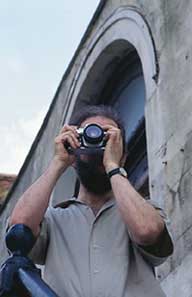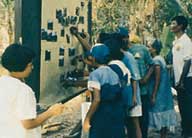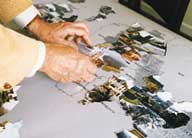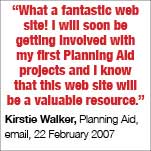Community Planning: Methods
Photo survey
- description
- more detail
- more pictures
Photo surveys help groups develop design ideas by taking and discussing photos of their existing environment. They can be used as part of a wider community profiling or action planning event or as an independent exercise
Participants go around their neighbourhood individually or in teams, taking photos of places and images according to a general or specific theme.
After processing, the photos are sorted, selected and placed on large sheets of blank paper or maps. Photos can be grouped or cut up and comments may be added using Post-its or felt tips.
The completed sheets or maps are used as a basis for discussion, analysis and design.
Participants go around their neighbourhood individually or in teams, taking photos of places and images according to a general or specific theme.
After processing, the photos are sorted, selected and placed on large sheets of blank paper or maps. Photos can be grouped or cut up and comments may be added using Post-its or felt tips.
The completed sheets or maps are used as a basis for discussion, analysis and design.
Photocredits
Hastings, UK, 1999, Greenhalf Photography
Hastings, UK, 1999, Greenhalf Photography

Taking photos
Making images of what is important for you in the local environment for sharing with others.
Tips
- Undertaking the whole exercise in one stretch builds a useful momentum but requires polaroid cameras, a fast development service (over lunch perhaps) or digital cameras and computers. Letting people take photos individually over a week can allow more thought but requires more self discipline.
- If not done automatically, record negative numbers on the back of prints before they are used. Get two sets of prints and keep negatives safe.
- Before and after photos can be highly effective. Dig out historical photos and take new ones from the same spot.
- After the photo survey is completed it can be useful to introduce photos from other places and make comparisons.
Costs
- Film and processing are expensive. If budgets are tight, give one film to each team and ensure the camera gets handed around. Using digital cameras is cheaper but requires more initial investment in equipment.
Photo survey process
Assuming a rapid 1-hour film processing facility is available nearby. If not, use polaroid cameras or split into 2 sessions.
Assuming a rapid 1-hour film processing facility is available nearby. If not, use polaroid cameras or split into 2 sessions.
- Briefing. Agree priorities
Briefing by facilitator. Agreement of objectives, timescales and themes.
Theme examples:- memorable places and images;
- beautiful places, ugly places;
- places to be alone, to socialise, to play;
- private places, public places;
- ugly buildings, beautiful buildings;
- threats
Divide into teams and hand out cameras and film. (30 mins).
- memorable places and images;
- Take photographs
Teams go round taking photos. (Teams can have the same or different themes.) (1 3 hours, depending on size of area)
- Process films during lunch break
Prints produced standard size are fine. (1.5 hours)
- Prepare presentation
Teams arrange photos on boards or paper sheets. Symbols and words added on Post-its to record comments, feelings and evaluations. Relevant photos grouped together. When completed (or time up) photos pinned or glued down. Sheets named and put up on wall. (1 hour)
- Exhibit
Viewing of exhibits. Tea break. (30 mins)
- Presentation
Each team presents their images and conclusions to a plenary session. Debate and discussion. Areas of agreement and disagreement recorded. (1 hour)
Ideal numbers: 6 teams of 68 max
Running time: 5.5 hours minimum.
Inspiration
-
"I was surprised how the photographs added a new dimension to everyone's perception."

Sorting photos
Villagers place photos of their own houses on a large map as an early step in a week-long planning workshop.
Photocredits
left: Igbalangao, Panay Island, Philippines. 1995. Nick Hall
right: Kent, UK, 1996, Debbie Bartlett
left: Igbalangao, Panay Island, Philippines. 1995. Nick Hall
right: Kent, UK, 1996, Debbie Bartlett

Cutting up photos
Photos being cut up and pasted on a large map to create a jigsaw display. Using this technique, people contribute photos which they think characterise their particular area. These are cut up to fit the given area of the map (perhaps a parish or plot). The end result is a vivid pictorial comparison of how people see their locality.
Thanks: Peter Richards, Deike Richards, Debbie Bartlett

